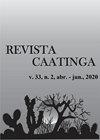Technical and economic indicators of papaya crops for the production factors water and organic compost
IF 0.9
4区 农林科学
Q3 AGRONOMY
引用次数: 0
Abstract
ABSTRACT The objective of this study was to analyze technical and economic indicators of responses of papaya (Carica papaya L.) to the production factors water and organic compost, in a rural property with characteristic of family farming in the Semiarid region of Brazil. The study was conducted from August 2019 to July 2020, in the first crop cycle, in the municipality of Pentecoste, Ceara, Brazil. A Formosa papaya crop (cultivar Tainung 1) was established with spacing of 2.5 × 2.5 m, and irrigated by a micro-sprinkler localized system. A randomized block design was used, with a split-plot arrangement and four replications. The primary treatments consisted of four irrigation water depths (60%, 80%, 100%, and 120% of the crop evapotranspiration), and the secondary treatments consisted of four organic compost rates (0%, 50%, 100%, and 150% of the required rate for the crop). The irrigation water productivity of 5.38 R$ (BRL) m-3, related to the requirements of the production factors, on average, is five-fold the reference value for papaya crops under conventional production system. Rural credit allows the farmer to reach a social reproduction level with a papaya crop area that can be, on average, half of that needed under conditions without financing.木瓜作物的技术经济指标为生产要素水分和有机堆肥
摘要本研究旨在分析巴西半干旱区具有家庭农业特征的农村番木瓜(Carica papaya L.)对生产要素、水分和有机堆肥响应的技术经济指标。该研究于2019年8月至2020年7月在巴西塞阿拉省五旬节市的第一个作物周期进行。以台农1号番木瓜为研究对象,栽培栽培间距为2.5 × 2.5 m,采用局部微喷系统灌溉。采用随机区组设计,分块排列,重复4次。一级处理为4种灌溉水深(作物蒸散量的60%、80%、100%和120%),二级处理为4种有机堆肥水平(作物所需水平的0%、50%、100%和150%)。灌溉水分生产力平均为5.38雷亚尔(BRL) m-3,与生产要素的要求有关,是常规生产系统下木瓜作物参考值的5倍。农村信贷使农民能够达到社会再生产水平,木瓜种植面积平均可以达到没有融资条件下所需面积的一半。
本文章由计算机程序翻译,如有差异,请以英文原文为准。
求助全文
约1分钟内获得全文
求助全文
来源期刊

Revista Caatinga
AGRONOMY-
CiteScore
2.10
自引率
11.10%
发文量
67
审稿时长
6-12 weeks
期刊介绍:
A Revista Caatinga é uma publicação científica que apresenta periodicidade trimestral, publicada pela Pró-Reitoria de Pesquisa e Pós-Graduação da Universidade Federal Rural do Semi-Árido – UFERSA, desde 1976.
Objetiva proporcionar à comunidade científica, publicações de alto nível nas áreas de Ciências Agrárias e Recursos Naturais, disponibilizando, integral e gratuitamente, resultados relevantes das pesquisas publicadas.
 求助内容:
求助内容: 应助结果提醒方式:
应助结果提醒方式:


